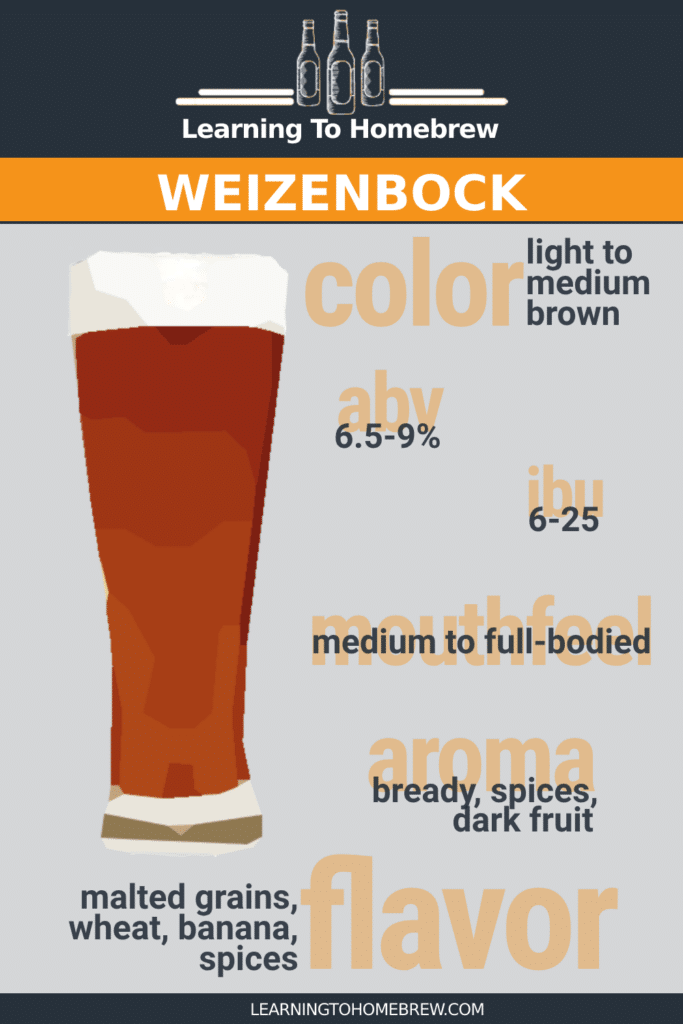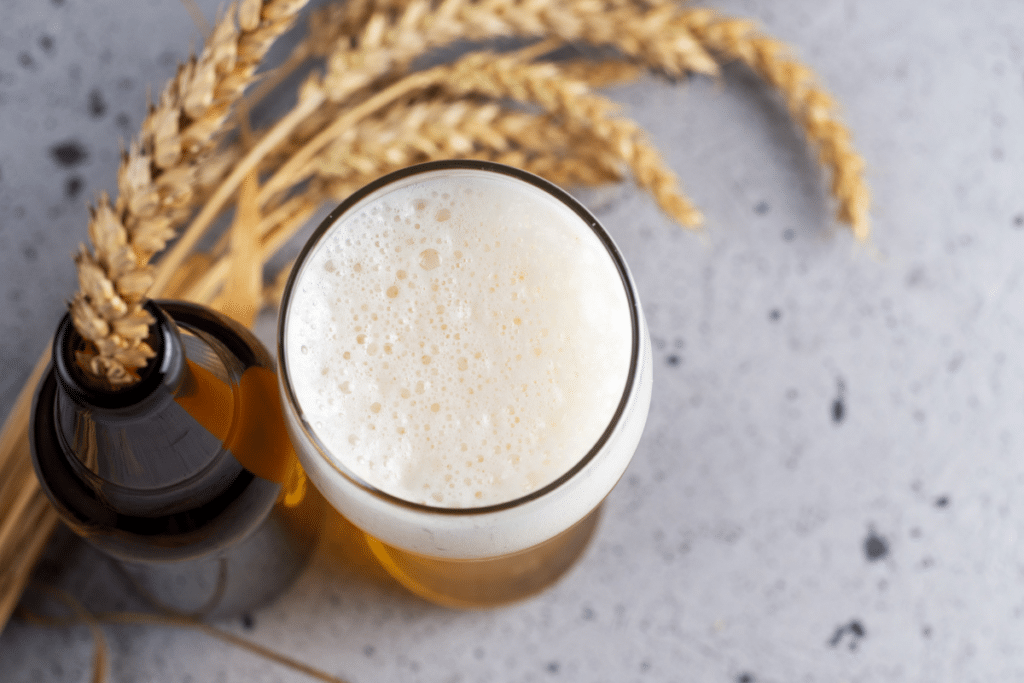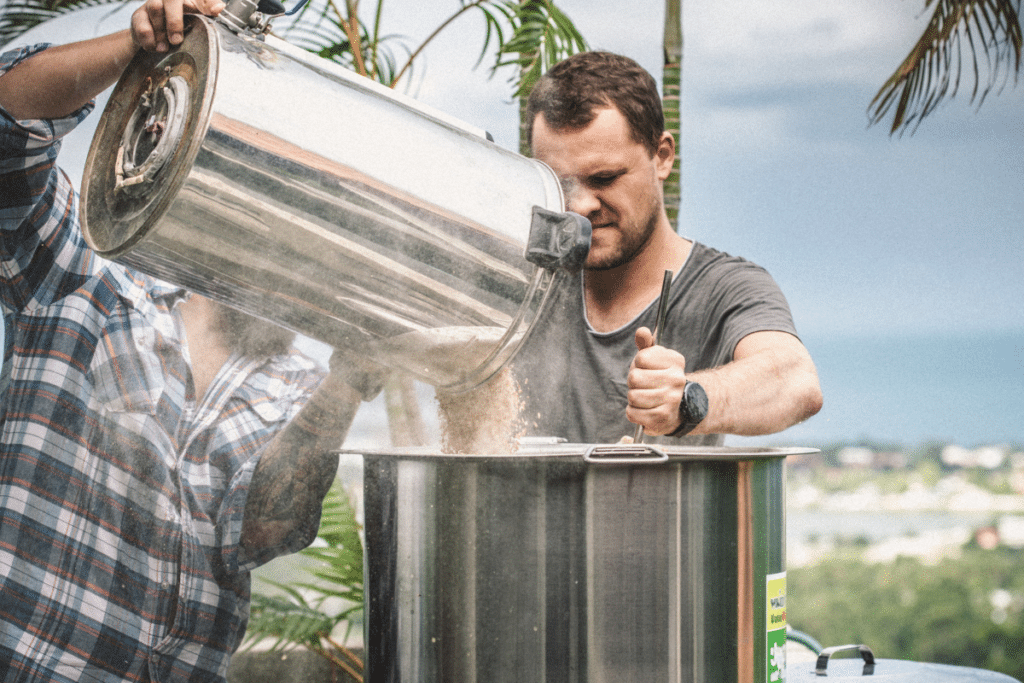There are several nations that are well-known for their beer, and Germany tops the list. Of the many delicious German beers, the Weizenbock is one of the most curious. A mix between a Weissbier and a Doppelbock, this beer can be a deliciously malty wheat beer. Once you’ve mastered brewing more common styles, it’s time to start looking into Weizenbock recipes!
Brew a complex Weizenbock with slightly hard water that has more chlorides than sulfates. Start with a grain bill primarily filled with wheat malt and your choice of Pilsner, Munich, Special B, or crystal malts. Use German hops solely for bittering. Lastly, use a medium attenuating yeast with low flocculation and low ester production.
A Weizenbock is incredibly satisfying to get right. Learn all about the style, what ingredients to use, and how to brew it below.
Topics We Cover
What is a Weizenbock?
A Weizenbock is either a pale or dark beer though most commonly dark.
It is a stronger German wheat beer with the typical wheat beer characteristics–banana, clove, and wheat flavors. Some dark Weizenbocks can also have fruity esters such as plums or raisins.
Weizenbocks are on the dryer side with a moderate alcohol presence depending on the ABV. Malt flavors are the star of this beer though there are several supporting flavors.
That said, hop flavors are nonexistent in this style. Hop bitterness on the other hand can be present. The bitterness should not detract from the main focus but add depth.
In some of the darker Weizenbocks, you can find dark fruits and caramel. Though they should not get too dark or heavy in flavor. Avoid adding roasted flavors.

Defining characteristics of the Weizenbock include:
- Color – 15-30 SRM (light to medium brown)
- Common flavors – Malted grains, wheat, banana, spices
- Aroma – Bready, spices, dark fruit
- Mouthfeel – Medium to full body, smooth, medium to high carbonation
- IBUs (Bitterness) – 6-25
- ABV – 6.5-9%
History of the Weizenbock
The Weizenbock is a blend of two different beer styles: the Doppelbock and Weissbier. Because of this, you can trace the roots of this style back to the first bock in the 12th century. Weizenbock itself is much younger.
The first Weizenbock was brewed in 1907 by G. Schneider & Sohn.
Prior to the Weizenbock, Weissbiers and other wheat beers were slowly losing popularity. Though they were historically well-loved, dark lagers were rapidly growing in popularity. By the time Georg Schneider acquired the right to brew wheat beer, it was nowhere near as popular as it had been.
G. Schneider & Sohn continued to brew wheat beers with decent success. It wasn’t until Georg III passed that the brewery created the Weizenbock. Mathilde Schneider, Georg III’s wife, took over and combined the brewery’s wheat beer with the popular Doppelbock.
This first Weizenbock was named Weizenbock Aventius after a Bavarian historian. The brewery is still active today and still brews Weizenbocks.
Popular commercial Weizenbocks
For the beer enthusiasts and the beer curious here’s a quick list of Weizenbocks you should try.
- Schnieder Weiss Mein Aventius – The original Weizenbock. This beer sits at 8.2% ABV with notes of toffee, dark fruits, and strong malt flavors. There’s a reason this beer has been around so long.
- Weihenstephan Vitus – This Weizenbock leans into the wheat beer characteristics. You can easily taste cloves with notes of banana. There are also notes of fruits such as dried apricot.
- Ayinger Weizenbock – From Ayinger Brewery comes a Weizenbock with notes of baked bread, cloves, honey, and hints of banana. It is a slightly earthy beer overall.
- Great Lakes Brewing Glockenspiel – Another classic Weizenbock with strong spice notes to go with the wheat notes. This 8% ABV beer will be sure to satisfy.
How to brew a Weizenbock
Once you’ve explored some great examples of a Weizenbock you may be thinking of how to brew your own. In order to brew the best beer you need to know the style forward and backward. To that end, I will break down everything you need to know.
Let’s start by going over some great choices for the recipe and ingredients. Then, we can look at the process including brew day, fermentation, and bottling.
Recipe and ingredients
While you can’t have beer without fermentation, you can’t get anywhere without quality ingredients. There are of course no wrong ingredients, but some will go together much better than others.
The recipes for this style typically use the same ingredients with some variation here and there:
- Water profile
- Base grains
- Specialty grains or other additions
- Hops
- Yeast
Below are some tips and guidelines to get you started, but feel free to experiment with the style.
Learn how to brew a Hefeweizen.
Water profile
A Weizenbock doesn’t need extremely hard water as it isn’t as dark as other beers. You won’t need to worry about the mash pH quite as much. That said, it doesn’t need soft water either.
The best water profile for a Weizenbock has a 2:1 ratio of chlorides to sulfates and is slightly hard water.
Keep the ratio of chlorides above sulfates. Chlorides will enhance the malt flavors of the beer while sulfates enhance hop flavors. Since a Weizenbock doesn’t use any hop flavors you won’t need sulfates.
Keep in mind that low levels of either will be hard to detect. Around 50 ppm of chlorides is a decent level to start experimenting with. The ratio is less important when the levels are very low.
Base grains
High-quality base grains make a big difference in a beer, even if they’re not the star of the show like they are here.
For a Weizenbock, you should use a wheat malt for most of the grain bill. This is both traditional and important for the flavor. If you want to use another base grain a pilsner malt also works well.

German varieties are appropriate but not essential. The Lovibond of the wheat is up to you and whether you’re brewing a pale or dark Weizenbock.
You can use wheat for the entire grain bill but it can add more to your beer if you use some specialty grains. However, using wheat for half of the grain bill is generally the minimum.
You may also be interested in: How to Brew an American Wheat (3 Recipes & Complete Style Guide!)
Specialty grains or other additions
Specialty grains allow you to really dial in the primary characteristics of your beer.
In a Weizenbock, you can use specialty grains such as Munich, Special B, or crystal malts. These malts generally should not be used for more than 30-40% of the grain bill. Though this rule can be bent as desired.
Specialty malts are mostly found in the darker Weizenbocks but light specialty malts can be used in pale Weizenbocks.
Hops
While hops are not the main focus of this beer you should still carefully choose a quality hop or two.
Hops in a Weizenbock should be used for bittering. The style does not call for hop flavors or aromas. Additionally, choose German hops to keep within tradition.
High alpha acid hops can work well if you want to reduce the amount of hop material.
Bittering
Bittering hops added early in the boil will go through a process called isomerization. This is what gives a beer its bitterness.
A Weizenbock calls for anywhere from 6 to 25 IBUs. Use small amounts of bittering hops by using high AA hops.
Here are some good choices for bittering hops.
| Name | Purpose | Alpha Acid % |
|---|---|---|
| Perle | Bittering + Aroma | 8-9% |
| Mandarina Bavaria | Aroma | 7-10% |
| Magnum | Bittering | 11-16% |
| Cascade | Bittering + Aroma | 4.5-9% |
Aroma and flavor
Aroma and flavor hops added towards the end of the boil don’t add much bitterness. Instead, they add oils that provide flavor and aroma.
Weizenbocks don’t need any hop aroma or flavors.
Yeast
Of course, you can’t have beer without yeast!
A Weizenbock calls for a yeast strain that has medium attenuation, low flocculation, and low to medium ester production. German yeast strains are best for this style.
As a wheat beer, you want some yeast suspended in the beer which means low flocculation. The attenuation level can be varied as desired since the beer is typically dry but not always. Then the esters should be dark fruit and not overpowering.
Dry
Below are some good dry yeast options for a Weizenbock.
| Name | Attenuation | Flocculation | Temperature Range |
|---|---|---|---|
| Safale WB-06 | 86-90% | Low | 64.4-78.8°F |
| Mangrove Jack’s M20 | 70-75% | Low | 59-86°F |
| Danstar Munich Classic | Medium-high | Low | 63-72°F |
Liquid
Below are some good liquid yeast options for a Weizenbock
| Name | Attenuation | Flocculation | Temperature Range |
|---|---|---|---|
| Wyeast 3068 | 73-77% | Low | 64-75°F |
| WLP300 | 72-76% | Low | 68-72°F |
| WLP380 | 73-80% | Low | 66-70°F |
Brewing process
After acquiring all of your ingredients you can move on to brew day. What you do on brew day can have just as much impact on your results as your choices of ingredients. On brew day, one of the most important aspects is sanitization. Be thorough when sanitizing.
All grain, partial, and extract brewing each have important considerations for you to make. When doing all-grain or partial brewing you need to consider mashing and sparging. From there the other considerations are similar. The boil step and on is the same for all three.

Let’s break down each step with the Weizenbock in mind.
Mashing
For a Weizenbock, your mash temperature should be between 152°F and 154°F. Within this range, the beer will be on the drier side. If you mash on the higher side, there will be some sweetness.
Something to consider is whether you do a typical single infusion mash or a decoction mash. The biggest deciding factor is personal preference. You can make a great Weizenbock with an infusion or decoction mashing.
Generally, decoction mashes add a more nuanced malt character to the beer. Doing a decoction mash can cause a Maillard reaction during the mash. This adds a little additional depth to the beer.
Additionally, you should perform a protein rest when you have a high percentage of wheat in the grain bill. Let your mash rest at around 122°F to 130°F for 20 minutes. This will help your mash out, break down proteins, and prepare the starches for conversion.
Alternatively, you can add rice hulls to your mash to help the mash out. Too much wheat can often cause a stuck mash.
Boil
The boil for a Weizenbock should be an hour to an hour and a half. All of your hop additions should be at the beginning or before the 30 minutes left mark.
If you boil slightly longer you can create more Maillard flavors. These are quite appropriate for the style, especially for the darker Weizenbocks. Otherwise, boil as normal.
Whirlpool or flameout
Boil aside, there are other times to add hops. They aren’t strictly necessary but can be great for adding flavor and aroma. You won’t need to do any flameout hop additions in this style.
Adding hops during flameout can be a great way to get the flavors and almost no bitterness. This is done directly after the boil and before you pitch yeast. As you transfer to your fermentor create a whirlpool as you drain the boiling vessel.
This is only possible when you have a vessel that can drain from the bottom. Whirlpooling can also be a great way to collect the trub in the middle and reduce the amount that gets in your fermentor.
Fermentation
As always, fermentation is crucial but mostly hands-off.
During Weizenbock fermentation make sure the temperatures don’t get too low. You want some ester production but don’t let the temps get too high. When pitching your yeast be aware that high pitching rates combined with over aerating can reduce banana and clove flavors.
Keeping the fermentation at a consistent temperature will help keep your brew clean from any fermentation byproducts. Temperature steps can help control what the yeast is doing.
Since this style calls for some fermentation byproducts don’t worry too much if the temps rise over fermentation.
Temperatures
While the temperatures are yeast dependent, there is a rough range you should keep your Weizenbock near.
Try to keep your fermentor around 65°F to 70°F for the majority of the process.
If you miss your temp goals by a few degrees or can’t keep it consistent, it won’t be the end of the world. This level of micromanaging is great for elevating your final product but isn’t essential.
Bottling or kegging
The debate between bottling and kegging will go on for as long as brewers have a choice. It is truly up to personal preference and setup.
There is little preference between bottling and kegging for Weizenbocks. Kegging will allow you to bulk condition while bottles can make it easier to save portions for aging.
Choose the method that is easiest for you.
Weizenbock recipes
If you aren’t one to create your own recipes here are a few that you can follow for great results. These recipes are from various brewers as credited below.
- Apricot Honey Hefeweizen (Partial)
- Imperial Hefeweizen (All Grain)
- Upper Hudson Valley Dark Weizenbock (All Grain)
Apricot Honey Hefeweizen (Partial)
This recipe comes from user Doc Bailey on Brewer’s Friend.
Ingredients
- German Vienna – 0.5 lb
- DME Wheat – 3.9 lb
- DME Pilsner – 1.95 lb
- Honey – 6 lb
- Apricot – 3 lb
- Hallertau hops – 1 oz
- Apricot extract – 4 oz
- Wyeast 3068
Method
- Heat 6 gallons of water for your boil.
- Add the steeping grains when the water is around 140°F.
- Steep for roughly 20 minutes.
- Remove the grains when the water is around 170°F.
- When a boil is reached, add the malt extract and honey.
- Boil for 60 minutes. Add the Hallertau right away.
- Flameout and transfer to the fermentor.
- Cool and pitch yeast.
- Maintain 65°F during fermentation.
- Just before transferring to secondary pasteurize the apricot.
- After a week or so in primary, rack to secondary and add the apricot and apricot extract.
- After another week rack to your keg and force carbonate or bottle condition.
Imperial Hefeweizen (All Grain)
This recipe comes from user C Gray on Brewer’s Friend.
Ingredients
- US Pilsner – 8 lb
- US White Wheat – 7 lb
- German Acidulated Malt – 0.25 lb
- Hallertau Hersbrucker hops – 1 oz
- Tettnanger hops – 1 oz
- Safale WB-06
Method
- Heat 6 gallons to 154°F.
- Add grain bill and mash for 1 hour.
- Protein rest at 122°F for 20 minutes
- Mashout.
- Collect 7 gallons of wort.
- Boil for 90 minutes.
- At 60 minutes left add 0.5 oz of the Hallertau and the Tettnanger.
- At 2 minutes left add the rest of the hops.
- Flameout. Then transfer to the fermentor.
- Cool and pitch yeast.
- Maintain 65° F during fermentation.
- After fermentation, rack to keg or bottles. Enjoy!
Upper Hudson Valley Dark Weizenbock (All Grain)
This recipe comes from user Professor Zymie on Brewer’s Friend.
Ingredients
- German Wheat Malt – 11.5 lb
- German Munich Light – 5.25 lb
- Belgian Special B – 1.25 lb
- German De-husked Caraf III – 0.25 lb
- Tradition hops GM – 2 oz
- Whirlfloc
- WLP300
Method
- Heat 6.15 gallons to 152°F,
- Add grain bill and mash for 1 hour.
- Protein rest at 122°F for 20 minutes
- Mashout.
- Collect 7.5 gallons of wort.
- Boil for 60 minutes. Add the hops immediately.
- At 15 minutes left add the whirlfloc.
- Flameout. Then transfer to the fermentor.
- Cool and pitch yeast.
- Maintain 65°F during fermentation.
- Rack to keg or bottles after about 2 weeks in primary. Enjoy!
Did you know that we have a full library of homebrew beer recipes for every style?

